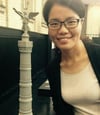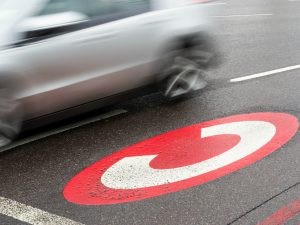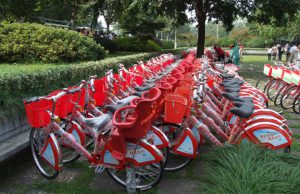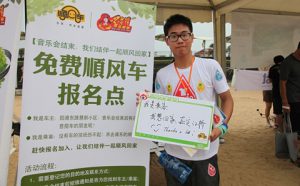It’s rush hour on a wintry morning after the Chinese New Year. Commuters dash from the subway station towards rows of red bicycles lined up next to a bus stop. With a quick swipe of a card, each person grabs a bike and they are off, disappearing into the crowd.
Between 80-90% of bikes on Hangzhou’s streets belong to the public ‘red’ bike hire scheme. Across the city, 3,000 rental points service a network of 84,000 bicycles. Around 280,000 bike journeys are made daily – making it the world’s largest public bike hire scheme. The scheme represents just one part of a public transport revolution that is shifting dependency away from petrol and diesel towards cleaner forms of energy.
(This film was shot and produced by Lydia McMullen-Laird and edited by Lu Wei)
The “Five-in-one” plan
Hangzhou, a city of 6.4 million people near Shanghai, will host this year’s G20 summit and has become synonymous with a new technology-driven approach to public transport design. Despite improvements, harmful vehicle emissions have continued to rise, forcing the government to go even further in its encouragement of greener transport and cleaner fuels.
In 2008, Hangzhou was designated one of eight Chinese cities to trial low-carbon schemes. Local authorities said Hangzhou’s consumption of fossil fuels could peak by 2020 – 10 years ahead of the national target. Efforts to replace coal use with gas, restructure industry and promote carbon trading began in earnest.
City planners decided to focus on the city’s creaking public transportation system, responsible for one-fifth of the city’s total emissions.
The scheme became known as the “Five-in-One” plan because it integrated five modes of transport into one single network: subway lines, buses, taxis, public hire bikes and river buses.
The bike hire scheme, started in 2009, was the first stage.
The world’s largest bike hire scheme
Between 2003 – 2005, 40% of journeys in Hangzhou were made by bicycle. The city is famous for its tea fields and West Lake, where tourists flock at weekends.
Its flat terrain and mild climate make cycling a popular choice. But over a decade ago the proportion of people cycling plunged as Hangzhou’s new middle classes began buying cars.
Hangzhou’s city planners began building a public bike hire scheme for locals and visitors in response to rising traffic congestion. It was China’s first.
Initially there were only 300 rental points clustered around scenic areas. By 2009, this had almost tripled to 800 rental points supporting a network of 20,000 bikes.
The second part of the plan was to introduce electric vehicles to reduce congestion and vehicle exhaust fumes. More recent innovations have included the introduction of low carbon road lighting and river shipping that uses less energy. Hangzhou’s 123-kilometre ring road is now lit by LED rather than sodium lights – saving 60% on electricity bills.
See also: Chinese cities crack down on electric bikes
Greener consumption
Hangzhou’s growing economy has attracted people and businesses, putting greater pressure on the local transport system in recent years and driving up emissions.
Part of the ongoing problem is Hangzhou’s energy structure – there is too much reliance on fossil fuels. In 2010 over 99% of transportation in the city was fuelled by diesel or petrol, despite efforts to address to prevent lock-in of such fuels in transport.
While these efforts have paid off to some extent – by 2013, the percentage of public transport dependent on fossil fuels had fallen to 96% – there is obviously still a long way to go.
A green future?
Over the next three years, Hangzhou is investing 800 million yuan in clean and new energy, which is expected to cut carbon emissions by 50,000 tonnes. Using clean energy is part of a bigger plan to reduce emissions which, it is hoped, will reduce carbon emissions from transportation by 310,000 tonnes by 2018.
“This year we’re rolling out 10,000 electric vehicles, 6,000 rental vehicles, 1,000 delivery vehicles, and 1,000 private cars,” said Zhu Yulong, head of the city’s transportation and shipping bureau. This includes a 500-strong fleet of electric buses to be put into operation before the G20 summit in September.
Benefits for businesses and commuters going electric include easier parking and fewer traffic restrictions.
Chinese household consumption is shifting from spending on food and clothes toward housing and travel, said Qi Ye, professor at Tsinghua University’s School of Public Policy and Management.
Chinese people now want better transportation and homes which will inevitably lead to emissions rising further, he said at the release of the China Low-Carbon Development Report 2015-2016.
But how to get people onto public transport? Du Xiangwan, a member of the Chinese Academy of Engineering, thinks that policy choices can guide people towards low-carbon lifestyles.
He offered Paris as an example. The French capital subsidises small cars and imposes higher taxes on large ones. And although there are five million cars in the city, the public transportation network is so good that many people prefer not to drive. Also, if PM2.5 levels reach 50, all public transport becomes free of charge so that drivers can be enticed to leave their cars at home.
Disruptive technologies
Despite the challenges, the way Hangzhou residents travel around the city has been transformed.
Ji Jinghang is head of the Hangzhou Low-Carbon Technology Museum and a member of Hangzhou’s army of cyclists. He says he rarely drives now that the subway is open and has not taken a taxi in almost a year.
Those who live further away from the city centre prefer “sharing” options – such as Uber and its Chinese counterpart Didi Da Che. Others opt to take a regular taxi to the nearest subway station then continue on public transport.
Taxi drivers, who are suffering a loss of business, are most disgruntled by the changes.
A short survey of Hangzhou taxi drivers by chinadialogue revealed that all but one are pessimistic about the new regulations. One driver said he would be looking for new work once his contract was up, while another complained of exhaustion from working extra hours to make up for shortfall in customers.
Zhang Liqiang says this must be understood in the context of market changes.
“Hangzhou has already set up a taxi drivers association to ensure the drivers have better rest and catering facilities. But we need to cut emissions. If car-sharing can reduce congestion and emissions, and make travel more convenient, that’s what will happen.”







